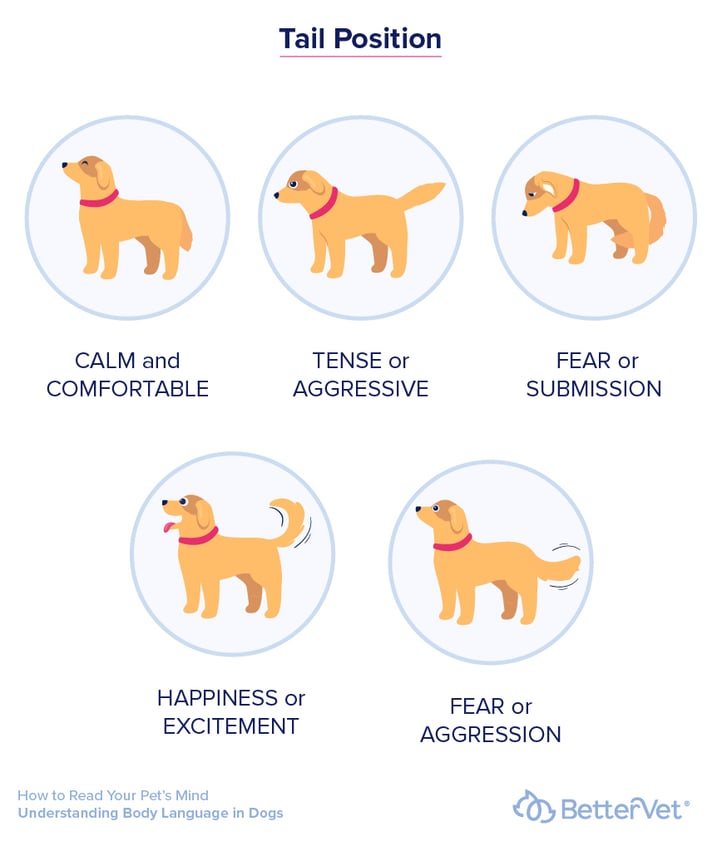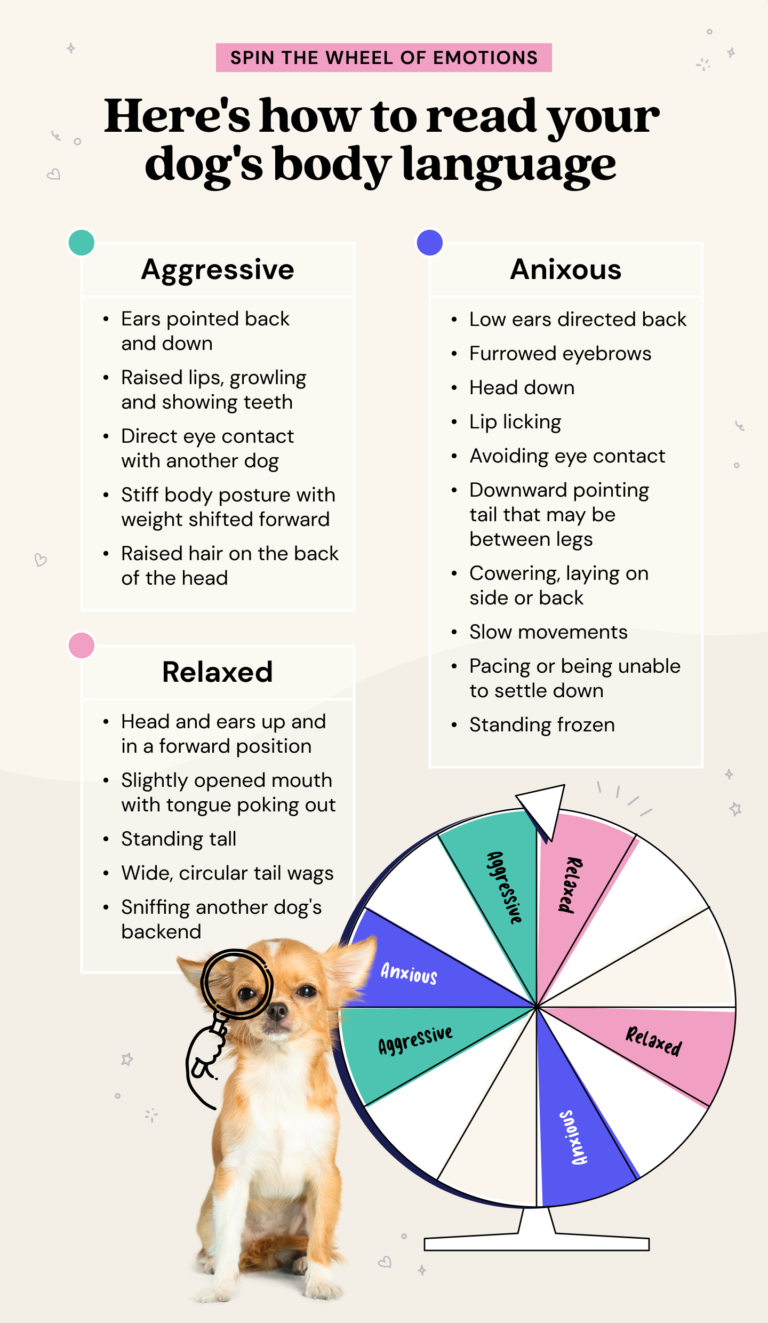A dog’s tail being down can indicate pain, discomfort, fear, anxiety, stress, submission, relaxation, or aggression, depending on the context and the dog’s overall behavior. It is important to observe other body language signs and consult a veterinarian to determine the exact reason for the tail being down.
Pain or discomfort in a specific area of the body, such as the tail or lower back, or a medical issue like a urinary tract infection, may cause a dog to hold its tail down. Additionally, a dog may lower its tail out of fear or anxiety in unfamiliar situations.
Understanding the various factors at play can help dog owners provide appropriate care and support for their furry friends.
Understanding Dog Body Language
Understanding dog body language is essential for pet owners to ensure a happy and healthy relationship with their furry friends. Dogs communicate their feelings and emotions through various cues, and one significant indicator is the position of their tail. When a dog’s tail is down, it can provide valuable insights into their overall state of being.
There are several reasons why a dog’s tail may be down:
- Pain or Discomfort: Dogs may lower their tails as a response to pain or discomfort. If your dog is experiencing pain in a particular area of their body, they may hold their tail down to alleviate discomfort.
- Emotional Distress: Just like humans, dogs can experience emotional distress, which can cause their tails to droop. Stress, anxiety, fear, or sadness can all lead to a downcast tail.
- Insecurity or Submissiveness: When a dog feels insecure or submissive, they may tuck their tail between their hind legs. This behavior is often seen when dogs are in unfamiliar surroundings or when they encounter dominant individuals or animals.
- Illness or Fatigue: If a dog is unwell or feeling fatigued, they may hold their tail in a lowered position. It can be an indicator of sickness or lack of energy.
A dog’s tail position can convey a lot about its emotions and mood. Here are some general interpretations:
| Tail Position | Meaning |
|---|---|
| High and wagging | Indicates happiness and excitement. |
| Low and wagging | Shows submissiveness or uncertainty. |
| Straight out and stiff | Can signal alertness or curiosity. |
If your dog’s tail is consistently down or if you notice any signs of discomfort, it’s crucial to consult with a veterinarian. Tail injuries, such as sprains, fractures, or nerve damage, can cause a permanent change in tail position. Additionally, health issues like arthritis or urinary tract infections can also lead to a drooping tail. Prompt medical attention is necessary to address any underlying problems and provide appropriate treatment.

Credit: www.petco.com
Why Is A Dog’s Tail Down?
A dog’s tail being down can indicate pain, discomfort, or submissiveness. It’s important to observe your dog’s behavior and consult a veterinarian if necessary.
Pain Or Discomfort
If a dog’s tail is down, it could be a sign of pain or discomfort. Dogs may lower their tails as a response to pain in a specific area of their body. This lowered tail position helps them alleviate discomfort and protect the injured area. It’s important to observe your dog closely to determine if they are exhibiting any other signs of pain or discomfort, such as limping or avoiding certain movements. If you suspect that your dog is experiencing pain, it is recommended to consult with a veterinarian for a proper diagnosis and appropriate treatment.
Medical Issues
Another possible reason for a dog’s tail being down is an underlying medical issue. Dogs may hold their tails down if they are experiencing a medical condition that causes discomfort or pain. For example, a urinary tract infection or an injury in the tail or lower back can lead to the tail being held in a lowered position. It is crucial to have your dog examined by a veterinarian to determine the cause of the lowered tail and provide the necessary medical treatment. They will be able to identify any potential medical issues and recommend the appropriate course of action.
Emotions And Mood
A dog’s tail position can also reflect their emotions and mood. When a dog’s tail is held low and wagging, it often indicates submissiveness or uncertainty. On the other hand, a high and wagging tail is a sign of happiness and excitement. If a dog’s tail is kept straight out and stiff, it can indicate alertness or curiosity. Therefore, it’s important to consider other behavioral cues and body language when interpreting a dog’s tail position. While a lowered tail can be a sign of pain or discomfort, it’s essential to assess the overall context of their behavior to determine the underlying cause.
Interpreting Different Tail Positions
When it comes to understanding dogs’ emotions and mood, their tail positions can serve as a valuable indicator. Dogs communicate through various body language signals, and their tail position is one of the most prominent cues. The position of a dog’s tail can reveal a lot about their emotional state, whether they are happy, submissive, alert, or in discomfort. In this section, we will explore three common tail positions and how to interpret them: high and wagging, low and wagging, and straight out and stiff.
High And Wagging
A dog’s tail held high and wagging is a clear sign of happiness and excitement. When a dog’s tail is raised high in the air and wagging vigorously, it indicates that they are content and approachable. This position often accompanies an enthusiastic and friendly demeanor. It is important to note that not all wagging tails indicate a positive emotional state. A high and wagging tail, in combination with relaxed body posture and open mouth, signifies a dog’s joy and willingness to interact.
Low And Wagging
On the other end of the spectrum, when a dog holds their tail low and wags it gently, it typically conveys submissiveness or uncertainty. Dogs may position their tail lower to display respect or deference to another dog or human. Low and wagging tail can also indicate nervousness or anxiety in certain situations. It is crucial to pay attention to other body language cues when interpreting a low and wagging tail. If a dog appears tense, with a lowered tail and flattened ears, it may suggest fear or a lack of confidence.
Straight Out And Stiff
When a dog’s tail is held straight out from the body and is stiff, it signals alertness or curiosity. This tail position shows that a dog is actively engaged with their environment and focused on something of interest. Dogs may exhibit this tail position when they encounter new objects, persons, or animals and want to gather more information. It is crucial to note that a stiffly held tail can also indicate aggression or a potential threat. Therefore, it is vital to assess the overall body language of a dog to accurately interpret their intentions.

Credit: bettervet.com
When To Be Concerned: Tail Injuries And Health Issues
When a dog’s tail is down, it could indicate pain, discomfort, or a medical issue such as an injury or urinary tract infection. Consulting a veterinarian will help determine the cause and provide appropriate treatment.
Sprains And Joint Injuries
If you notice that your dog’s tail is down and they are exhibiting signs of discomfort or pain, it could be a result of a sprain or joint injury. Just like humans, dogs can experience sprains or strains in their tail. This can happen due to overexertion, sudden movements, or trauma.
Common symptoms of sprains and joint injuries in a dog’s tail include:
- Limpness or difficulty in wagging the tail
- Swelling or bruising around the tail area
- Pain or tenderness when the tail is touched or manipulated
- Reluctance to move or participate in activities that involve the tail
If you suspect that your dog has a sprained or injured tail, it’s important to consult with a veterinarian. They can perform a thorough examination and provide appropriate treatment options, which may include rest, pain management, or physical therapy.
Fear And Anxiety
Fear and anxiety can cause a dog’s tail to be down or tucked between their legs. Dogs are highly sensitive animals and can easily pick up on their owner’s emotions or environmental stressors. If a dog is feeling scared or anxious, they may exhibit signs of fear by lowering their tail.
Common signs of fear and anxiety in dogs include:
- Tail tucked between the legs
- Cowering or hiding
- Trembling or shaking
- Excessive panting or drooling
- Refusing to eat or drink
If your dog’s tail is down and you suspect fear or anxiety as the cause, it’s important to create a safe and calming environment for them. Provide them with a quiet and comfortable space, offer positive reinforcement, and consider consulting with a professional dog trainer or behaviorist for assistance.
Other Health Issues
In addition to sprains, joint injuries, fear, and anxiety, a dog’s tail being down can also indicate other underlying health issues. These health issues can range from minor discomfort to more serious medical conditions.
Here are some possible health problems associated with a dog’s tail being down:
| Health Issue | Symptoms |
|---|---|
| Urinary tract infection | Increase in urination or accidents in the house |
| Herniated disc | Limping, difficulty walking, or paralysis |
| Anal gland issues | Scooting, excessive licking or biting of the tail area |
| Inflammatory conditions | Redness, swelling, or discharge around the tail |
If you suspect that your dog’s tail being down is caused by a health issue, it’s crucial to consult with a veterinarian. They can conduct a thorough examination, run any necessary tests, and provide appropriate treatment options based on the underlying condition.

Credit: www.innovetpet.com
Frequently Asked Questions On What Does It Mean When A Dog’s Tail Is Down
Why Is My Dog’s Tail Down All Of A Sudden?
A dog’s tail may be down suddenly due to pain or discomfort. It could be a response to an injury, arthritis, or a medical issue. It’s important to have your dog examined by a veterinarian for proper diagnosis and treatment.
Why Is My Dog Walking With His Tail Down?
When a dog walks with his tail down, it could be a sign of pain, discomfort, injury, arthritis, or a medical issue. It’s important to have your dog examined by a veterinarian for proper diagnosis and treatment.
Is My Dog In Pain If His Tail Is Down?
If your dog’s tail is down, it could indicate pain or discomfort. Dogs may lower their tails in response to pain or as a way to alleviate discomfort. It’s important to have your dog examined by a veterinarian to determine the cause and provide appropriate treatment.
What Dog Tail Position Means?
A dog’s tail position can indicate its emotions and mood. A high and wagging tail shows happiness and excitement, while a low and wagging tail indicates submissiveness or uncertainty. A straight out and stiff tail can signal alertness or curiosity.
Conclusion
When a dog’s tail is down, it can indicate various emotional states and physical discomfort. A lower tail position may suggest fear, anxiety, pain, stress, submission, or even relaxation. It’s essential to pay attention to other body language cues and consult with a veterinarian if necessary.
Understanding your dog’s tail language can help strengthen your bond and ensure their well-being.



